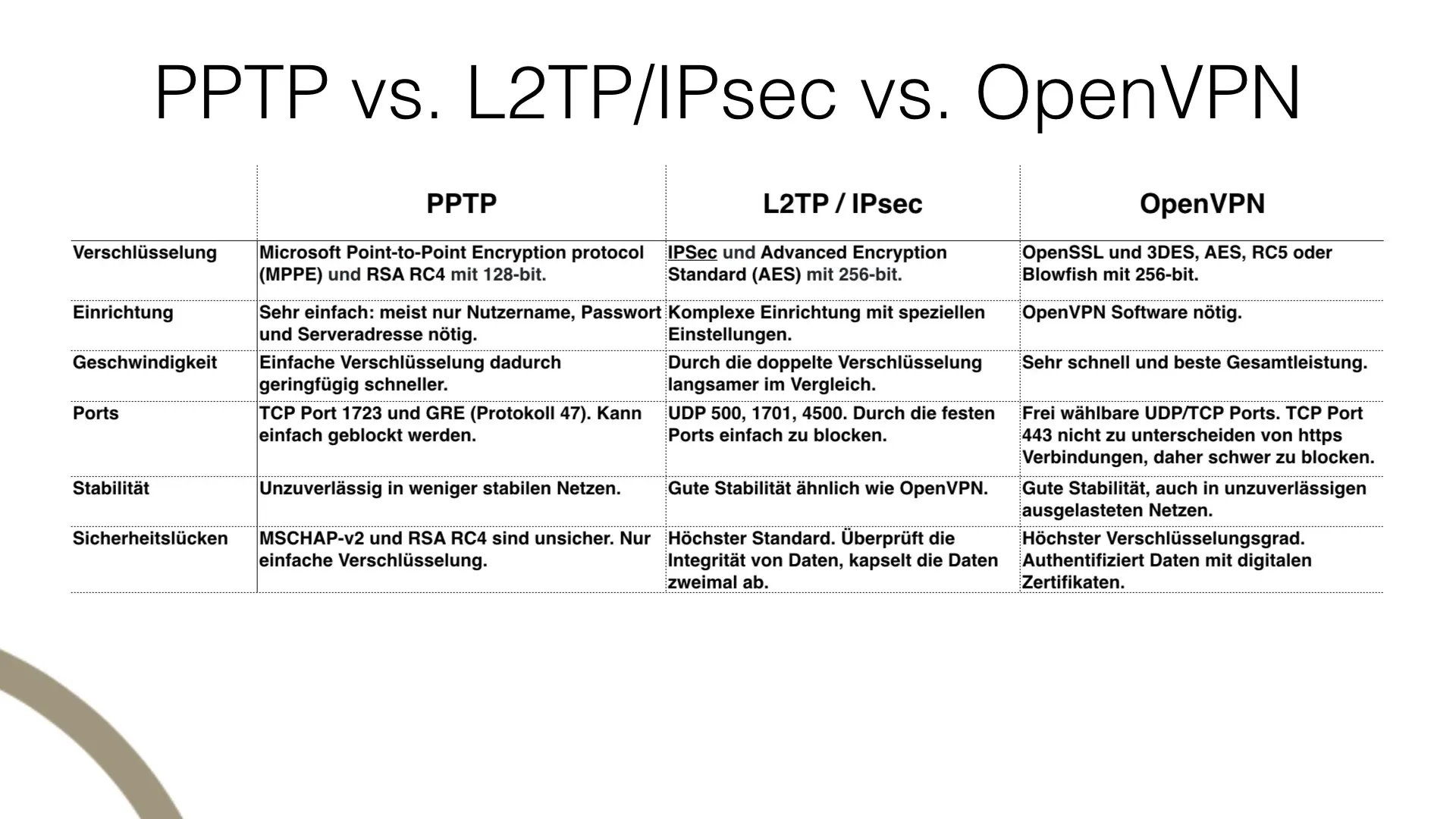The choice of the right VPN-protocol is crucial for the security and performance of your network. Different protocols provide various use cases, advantages, and disadvantages. This comprehensive guide compares the three most common VPN protocols – PPTP, L2TP/IPSec, and OpenVPN. You will learn which protocol best fits your needs and how to set it up.
Key takeaways
- PPTP is fast but offers weak encryption.
- L2TP/IPSec is secure but complex to set up.
- OpenVPN provides an excellent balance between security and performance.
Step-by-step Guide
Master of Protocols – PPTP, L2TP/IPSec, and OpenVPN
Let's start with an overview of the three protocols. PPTP uses a simple Point-to-Point Encryption (PPE) with 128 bits, which is considered weak but is very fast. It is ideal for situations where speed is more important than security. Imagine you just want to quickly access an online service without investing much time in configuration. This is where PPTP excels.

In contrast, L2TP/IPSec offers more robust encryption with 256-bit AES standard security, which is hard to crack. However, the setup is more complex, as special settings and additional tools are required. With such protocols, it is important that you, as a user, follow the right steps to make all necessary configurations.
OpenVPN, on the other hand, uses the OpenSSL library, meaning it can access a variety of encryption algorithms. By default, it uses Blowfish with 128 bits but can be configured to higher key sizes. OpenVPN is the preferred choice for many experts as it offers the best combination of security and performance.
Steps to Configure
Setting up a PPTP tunnel is relatively easy. You only need a username, a password, and the server address. The Windows interface allows you to enter this information in a few clicks. This way, you can immediately establish a PPTP tunnel and use the connection.
Configuring L2TP/IPSec, however, requires more effort. You need specific settings and tools for this. The setup can become complicated due to the numerous required factors, such as various libraries in the background. Make sure you follow all configuration options to establish a stable tunnel.
OpenVPN, on the other hand, comes with its own software that you can install. To set it up, you need to adjust a configuration file in text form. Here you have an almost endless selection of options to determine the exact functionality of your VPN. The challenge is finding the right balance and knowing which options are best suited for your scenario.
Speed and Performance of Protocols
Speed is a crucial factor. PPTP achieves faster speeds due to its simple encryption methods. Compared to L2TP/IPSec, it is significantly faster, but one should not ignore the disadvantages of weak security.
L2TP/IPSec offers balanced security, but double encryption can affect speed. OpenVPN operates at a good speed compared to PPTP but is not quite as fast. Nevertheless, it is highly preferred for its security and functionality.
Port Usage with Different Protocols
PPTP uses standard ports that can be relatively easily detected by firewalls, which poses a security risk. L2TP/IPSec also has fixed ports, making it easier for firewalls to block it. Here lies an advantage of OpenVPN, as it uses freely selectable UDP or TCP ports. This complicates detection and blocking by network administrators.
Stability and Security Vulnerabilities
In less stable networks, PPTP often has problems, which is why it is not recommended for security-critical applications. L2TP/IPSec displays a similar stability to OpenVPN and is therefore regarded as a reliable alternative.
Regarding security vulnerabilities, PPTP has a worse standing due to insecure encryption methods than L2TP/IPSec and OpenVPN. The latter uses digital certificates for authentication, offering a higher security standard.

Protocol Compatibility
Today, there are numerous options for implementation; the use of OpenVPN is possible on Windows, Linux, and various platforms such as macOS and iOS. This extensive compatibility is a significant advantage of OpenVPN compared to older protocols.
Summary – Setting Up and Understanding OpenVPN: Comparison of PPTP, L2TP/IPSec, and OpenVPN
In this guide, you have learned how to set up the different VPN protocols and compare them in terms of security, speed, and stability. It is essential to understand the specific requirements of your network to choose the most suitable protocol.
Frequently Asked Questions
How secure is PPTP?PPTP is considered insecure as it uses weak encryption (128 bits).
What is the main advantage of OpenVPN?OpenVPN offers an excellent balance between security and speed and is highly customizable.
How complicated is the setup of L2TP/IPSec?The setup of L2TP/IPSec is more complex than that of PPTP, as specific settings and tools are required.
Can OpenVPN be used on all operating systems?Yes, OpenVPN is well compatible with Windows, macOS, Linux, and mobile platforms.
Why should PPTP be avoided?PPTP has security flaws and is vulnerable in stable networks.


